Emotional Intelligence: Workplace Application and Development
VerifiedAdded on 2020/03/07
|5
|982
|76
Report
AI Summary
This report delves into the concept of emotional intelligence (EI), defining it as the ability to understand and manage one's own emotions and those of others to influence behavior effectively. The report explores the five core constructs of EI: self-awareness, self-regulation, social skills, empathy, and motivation, with a personal reflection on strengths and weaknesses in emotional responses. It provides examples of EI application in business scenarios, such as promoting a coworker, navigating cultural differences, adapting communication styles, and influencing others. The report also highlights strategies for developing EI in others, including providing opportunities for feedback and facilitating team meetings to enhance relationships and foster a positive work environment. The ultimate goal is to create a positive organizational culture and improve overall employee productivity through the development of emotional intelligence.
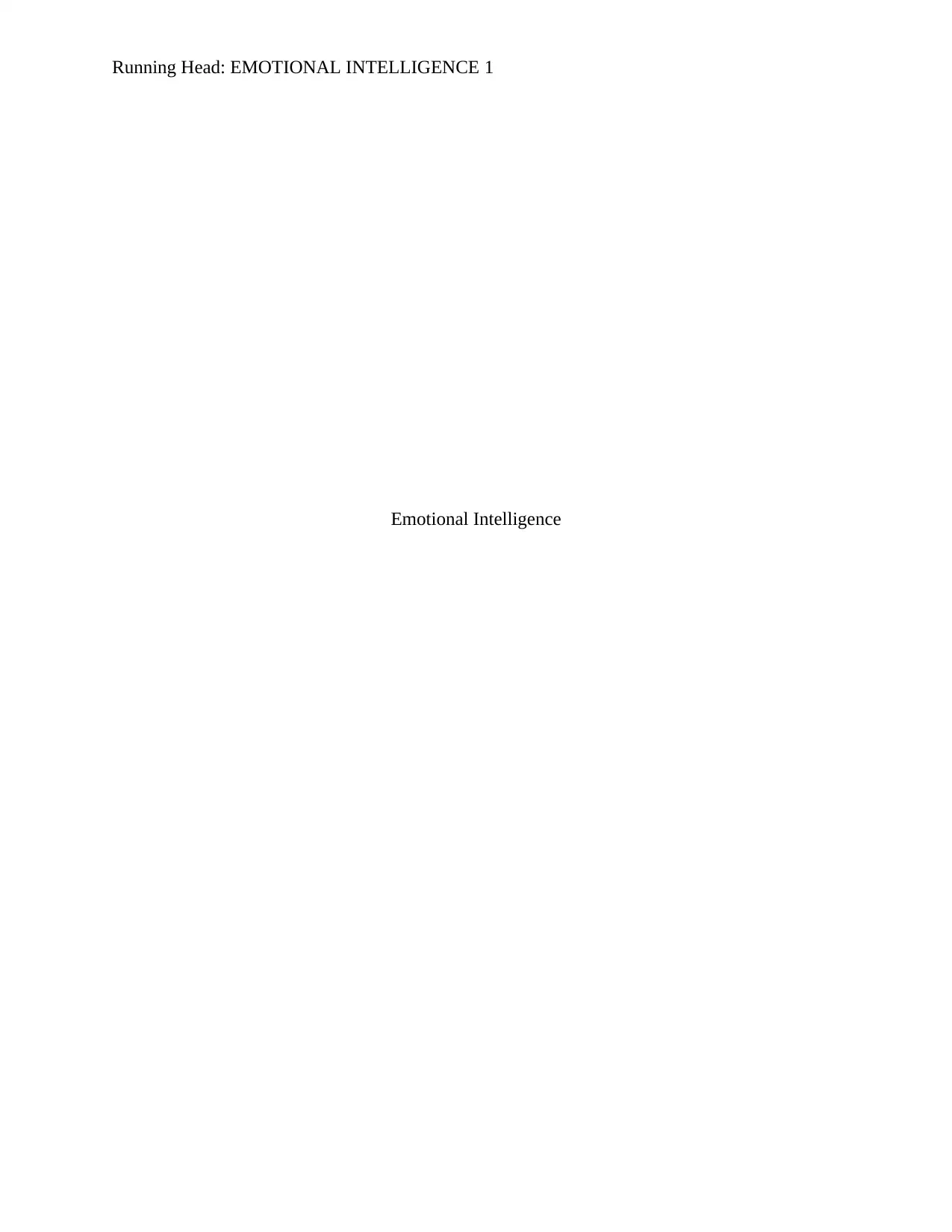
Running Head: EMOTIONAL INTELLIGENCE 1
Emotional Intelligence
Emotional Intelligence
Paraphrase This Document
Need a fresh take? Get an instant paraphrase of this document with our AI Paraphraser
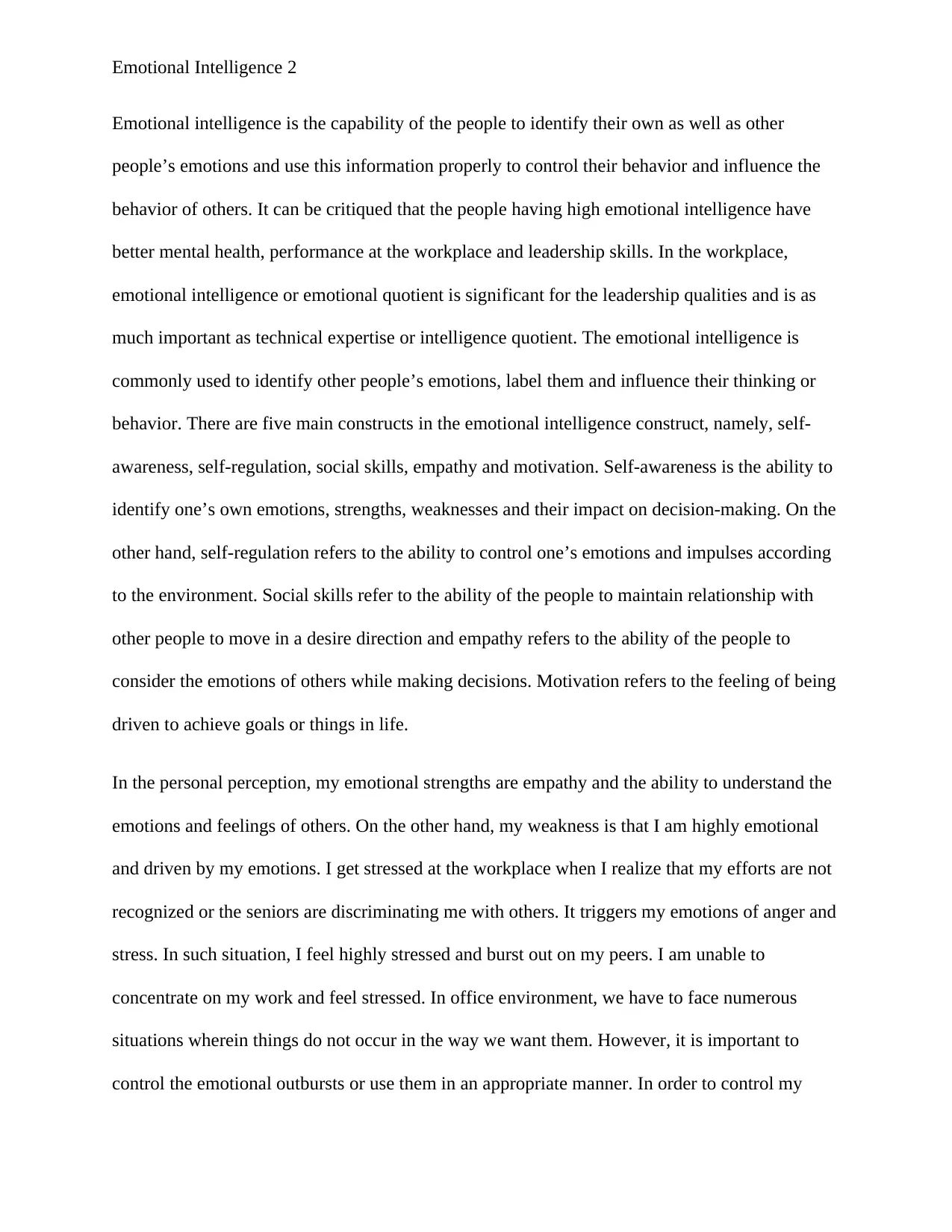
Emotional Intelligence 2
Emotional intelligence is the capability of the people to identify their own as well as other
people’s emotions and use this information properly to control their behavior and influence the
behavior of others. It can be critiqued that the people having high emotional intelligence have
better mental health, performance at the workplace and leadership skills. In the workplace,
emotional intelligence or emotional quotient is significant for the leadership qualities and is as
much important as technical expertise or intelligence quotient. The emotional intelligence is
commonly used to identify other people’s emotions, label them and influence their thinking or
behavior. There are five main constructs in the emotional intelligence construct, namely, self-
awareness, self-regulation, social skills, empathy and motivation. Self-awareness is the ability to
identify one’s own emotions, strengths, weaknesses and their impact on decision-making. On the
other hand, self-regulation refers to the ability to control one’s emotions and impulses according
to the environment. Social skills refer to the ability of the people to maintain relationship with
other people to move in a desire direction and empathy refers to the ability of the people to
consider the emotions of others while making decisions. Motivation refers to the feeling of being
driven to achieve goals or things in life.
In the personal perception, my emotional strengths are empathy and the ability to understand the
emotions and feelings of others. On the other hand, my weakness is that I am highly emotional
and driven by my emotions. I get stressed at the workplace when I realize that my efforts are not
recognized or the seniors are discriminating me with others. It triggers my emotions of anger and
stress. In such situation, I feel highly stressed and burst out on my peers. I am unable to
concentrate on my work and feel stressed. In office environment, we have to face numerous
situations wherein things do not occur in the way we want them. However, it is important to
control the emotional outbursts or use them in an appropriate manner. In order to control my
Emotional intelligence is the capability of the people to identify their own as well as other
people’s emotions and use this information properly to control their behavior and influence the
behavior of others. It can be critiqued that the people having high emotional intelligence have
better mental health, performance at the workplace and leadership skills. In the workplace,
emotional intelligence or emotional quotient is significant for the leadership qualities and is as
much important as technical expertise or intelligence quotient. The emotional intelligence is
commonly used to identify other people’s emotions, label them and influence their thinking or
behavior. There are five main constructs in the emotional intelligence construct, namely, self-
awareness, self-regulation, social skills, empathy and motivation. Self-awareness is the ability to
identify one’s own emotions, strengths, weaknesses and their impact on decision-making. On the
other hand, self-regulation refers to the ability to control one’s emotions and impulses according
to the environment. Social skills refer to the ability of the people to maintain relationship with
other people to move in a desire direction and empathy refers to the ability of the people to
consider the emotions of others while making decisions. Motivation refers to the feeling of being
driven to achieve goals or things in life.
In the personal perception, my emotional strengths are empathy and the ability to understand the
emotions and feelings of others. On the other hand, my weakness is that I am highly emotional
and driven by my emotions. I get stressed at the workplace when I realize that my efforts are not
recognized or the seniors are discriminating me with others. It triggers my emotions of anger and
stress. In such situation, I feel highly stressed and burst out on my peers. I am unable to
concentrate on my work and feel stressed. In office environment, we have to face numerous
situations wherein things do not occur in the way we want them. However, it is important to
control the emotional outbursts or use them in an appropriate manner. In order to control my
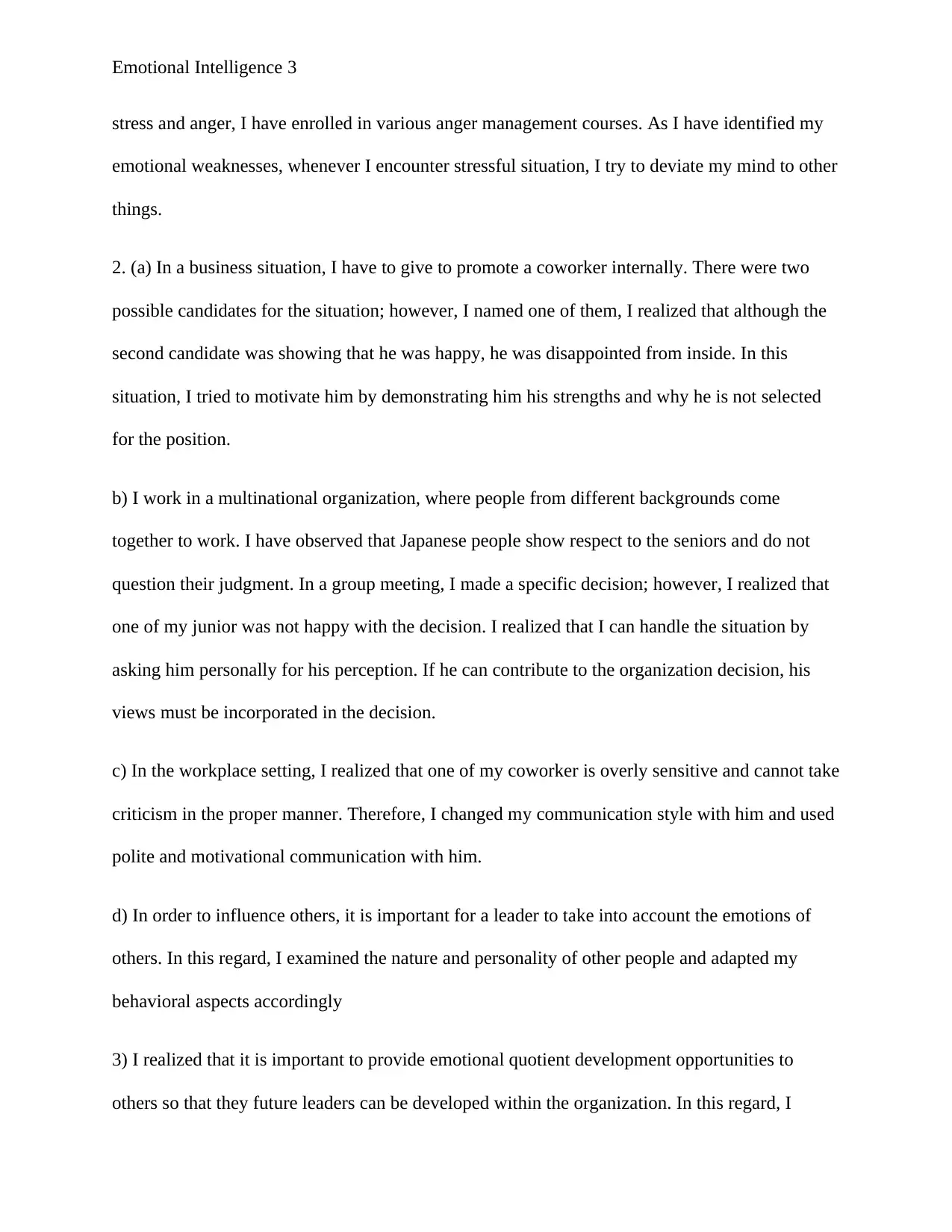
Emotional Intelligence 3
stress and anger, I have enrolled in various anger management courses. As I have identified my
emotional weaknesses, whenever I encounter stressful situation, I try to deviate my mind to other
things.
2. (a) In a business situation, I have to give to promote a coworker internally. There were two
possible candidates for the situation; however, I named one of them, I realized that although the
second candidate was showing that he was happy, he was disappointed from inside. In this
situation, I tried to motivate him by demonstrating him his strengths and why he is not selected
for the position.
b) I work in a multinational organization, where people from different backgrounds come
together to work. I have observed that Japanese people show respect to the seniors and do not
question their judgment. In a group meeting, I made a specific decision; however, I realized that
one of my junior was not happy with the decision. I realized that I can handle the situation by
asking him personally for his perception. If he can contribute to the organization decision, his
views must be incorporated in the decision.
c) In the workplace setting, I realized that one of my coworker is overly sensitive and cannot take
criticism in the proper manner. Therefore, I changed my communication style with him and used
polite and motivational communication with him.
d) In order to influence others, it is important for a leader to take into account the emotions of
others. In this regard, I examined the nature and personality of other people and adapted my
behavioral aspects accordingly
3) I realized that it is important to provide emotional quotient development opportunities to
others so that they future leaders can be developed within the organization. In this regard, I
stress and anger, I have enrolled in various anger management courses. As I have identified my
emotional weaknesses, whenever I encounter stressful situation, I try to deviate my mind to other
things.
2. (a) In a business situation, I have to give to promote a coworker internally. There were two
possible candidates for the situation; however, I named one of them, I realized that although the
second candidate was showing that he was happy, he was disappointed from inside. In this
situation, I tried to motivate him by demonstrating him his strengths and why he is not selected
for the position.
b) I work in a multinational organization, where people from different backgrounds come
together to work. I have observed that Japanese people show respect to the seniors and do not
question their judgment. In a group meeting, I made a specific decision; however, I realized that
one of my junior was not happy with the decision. I realized that I can handle the situation by
asking him personally for his perception. If he can contribute to the organization decision, his
views must be incorporated in the decision.
c) In the workplace setting, I realized that one of my coworker is overly sensitive and cannot take
criticism in the proper manner. Therefore, I changed my communication style with him and used
polite and motivational communication with him.
d) In order to influence others, it is important for a leader to take into account the emotions of
others. In this regard, I examined the nature and personality of other people and adapted my
behavioral aspects accordingly
3) I realized that it is important to provide emotional quotient development opportunities to
others so that they future leaders can be developed within the organization. In this regard, I
⊘ This is a preview!⊘
Do you want full access?
Subscribe today to unlock all pages.

Trusted by 1+ million students worldwide
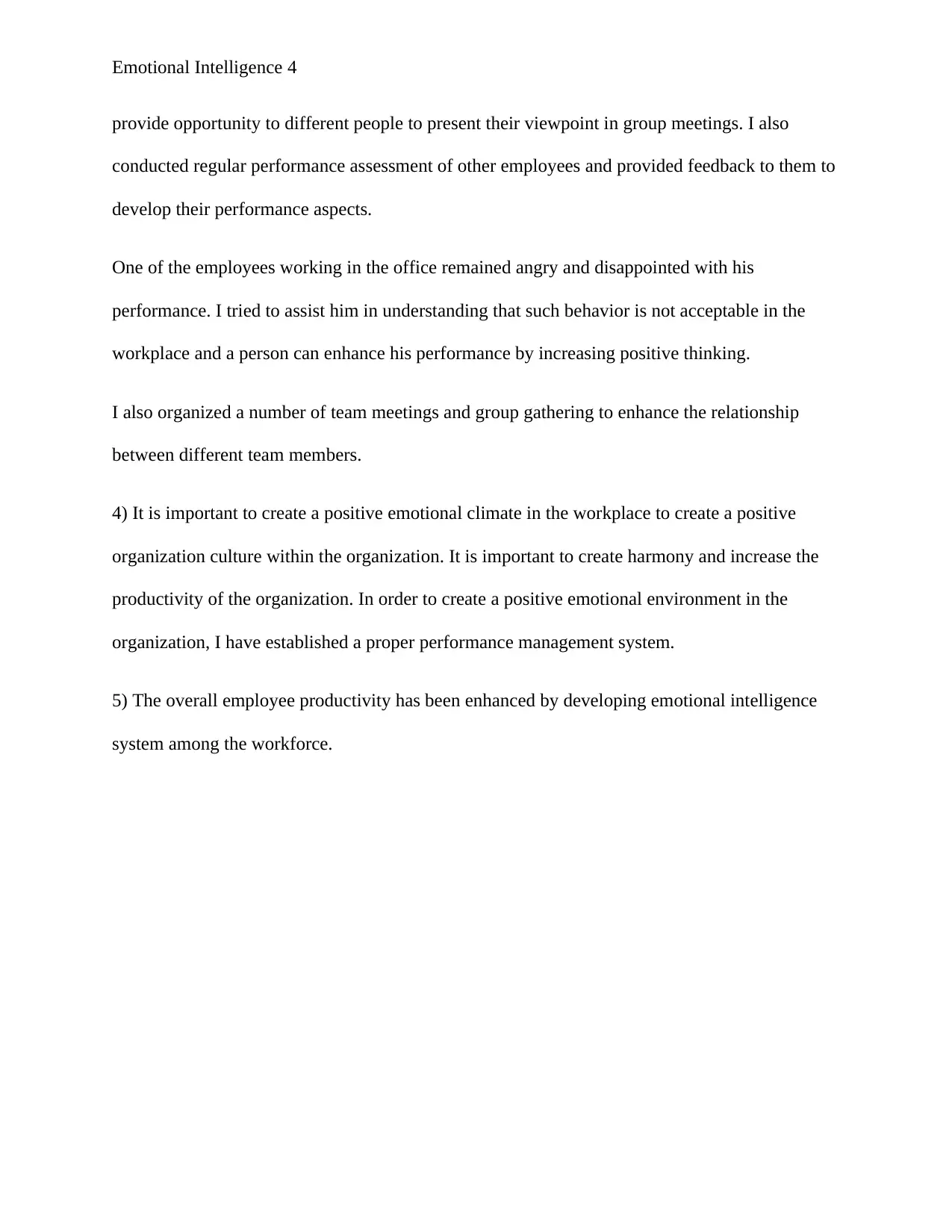
Emotional Intelligence 4
provide opportunity to different people to present their viewpoint in group meetings. I also
conducted regular performance assessment of other employees and provided feedback to them to
develop their performance aspects.
One of the employees working in the office remained angry and disappointed with his
performance. I tried to assist him in understanding that such behavior is not acceptable in the
workplace and a person can enhance his performance by increasing positive thinking.
I also organized a number of team meetings and group gathering to enhance the relationship
between different team members.
4) It is important to create a positive emotional climate in the workplace to create a positive
organization culture within the organization. It is important to create harmony and increase the
productivity of the organization. In order to create a positive emotional environment in the
organization, I have established a proper performance management system.
5) The overall employee productivity has been enhanced by developing emotional intelligence
system among the workforce.
provide opportunity to different people to present their viewpoint in group meetings. I also
conducted regular performance assessment of other employees and provided feedback to them to
develop their performance aspects.
One of the employees working in the office remained angry and disappointed with his
performance. I tried to assist him in understanding that such behavior is not acceptable in the
workplace and a person can enhance his performance by increasing positive thinking.
I also organized a number of team meetings and group gathering to enhance the relationship
between different team members.
4) It is important to create a positive emotional climate in the workplace to create a positive
organization culture within the organization. It is important to create harmony and increase the
productivity of the organization. In order to create a positive emotional environment in the
organization, I have established a proper performance management system.
5) The overall employee productivity has been enhanced by developing emotional intelligence
system among the workforce.
Paraphrase This Document
Need a fresh take? Get an instant paraphrase of this document with our AI Paraphraser
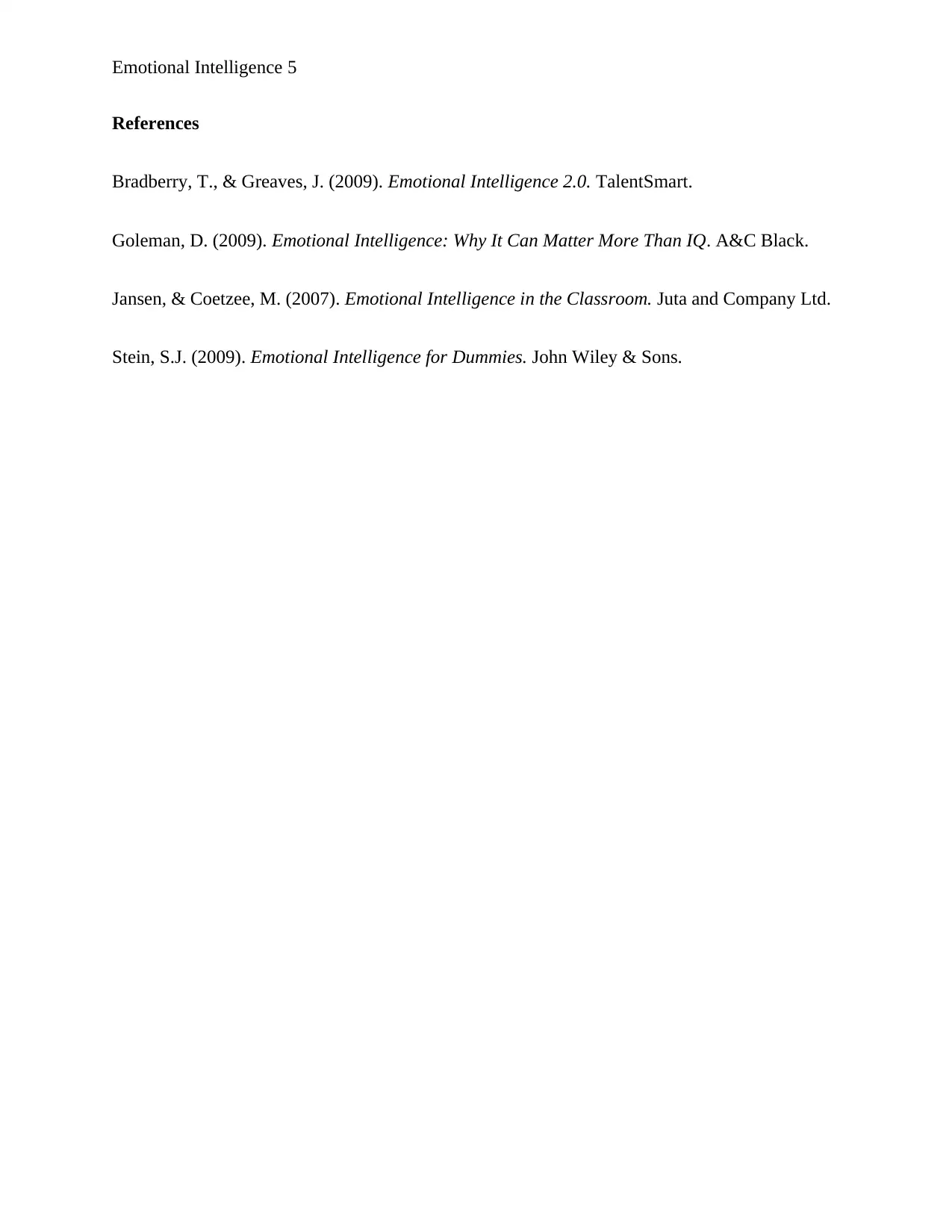
Emotional Intelligence 5
References
Bradberry, T., & Greaves, J. (2009). Emotional Intelligence 2.0. TalentSmart.
Goleman, D. (2009). Emotional Intelligence: Why It Can Matter More Than IQ. A&C Black.
Jansen, & Coetzee, M. (2007). Emotional Intelligence in the Classroom. Juta and Company Ltd.
Stein, S.J. (2009). Emotional Intelligence for Dummies. John Wiley & Sons.
References
Bradberry, T., & Greaves, J. (2009). Emotional Intelligence 2.0. TalentSmart.
Goleman, D. (2009). Emotional Intelligence: Why It Can Matter More Than IQ. A&C Black.
Jansen, & Coetzee, M. (2007). Emotional Intelligence in the Classroom. Juta and Company Ltd.
Stein, S.J. (2009). Emotional Intelligence for Dummies. John Wiley & Sons.
1 out of 5
Related Documents
Your All-in-One AI-Powered Toolkit for Academic Success.
+13062052269
info@desklib.com
Available 24*7 on WhatsApp / Email
![[object Object]](/_next/static/media/star-bottom.7253800d.svg)
Unlock your academic potential
Copyright © 2020–2025 A2Z Services. All Rights Reserved. Developed and managed by ZUCOL.




